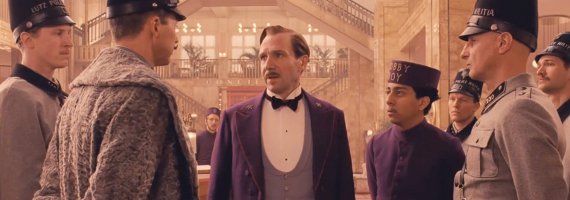
The Grand Budapest Hotel (2014) Directed by Wes Anderson. Starring: Ralph Fiennes, Tony Revolori, & Saoirse Ronan. IMDB says: “The adventures of Gustave H, a legendary concierge at a famous European hotel between the wars, and Zero Moustafa, the lobby boy who becomes his most trusted friend.”

The Grand Budapest Hotel is spectacular. It’s Wes Anderson’s most extravagant and most star studded film to date, and it doesn’t disappoint. Don’t let the trailers fool you, its a murder mystery prison break film done only in the way Wes Anderson can. The film bounces between three time lines and tells the story of Zero (Tony Revolori) and his relationship with M. Gustave (Ralph Fiennes) while working at the Grand Budapest Hotel, the grandest hotel in all of the fictional Republic of Zubrowka. Gustave takes Zero under wing and teaches him how to be the best concierge all while having affairs with older women. MUCH older women. Things are grand (I keep using that word, and I’m going to keep using that word) until one of the older guests dies and leaves Gustave with a prized family possession. The family wants said item and frames Gustave for the murder. He gets sent to prison, and the film is off to the races from there.
The film is overflowing with actors, both Anderson vets and newcomers alike. It’s great, but at the same time, it introduces so many side characters, that their screen time is cut short and their stories aren’t as fully developed as some might want. My only complaint in that department is I could have used more Jeff Goldblum and Tom Wilkinson. (Wilkinson we only see for a total of maybe 5 minutes, and as far as Goldblum is concerned, well, everyone could use more Goldblum) But when they’re tossed into the mix with Owen Wilson, a nearly unrecognizable Tilda Swinton, Jason Schwartzman, Ed Norton, Bill Murray (his 7th Anderson film appearance), Harvey Keitel, Jude Law, Adrien Brody, F. Murray Abraham, Bob Balaban, and Waris Ahluwalia, you don’t seem to mind as much.
The film features a fantastic score from Alexandre Desplat that adds to a film that already stands out as Anderson’s most lavish and extravagant film to date. Set pieces are bigger, fabrics are fanciers, colors are bolder and richer, and at times, it feels like a storybook come to life. The film does something interesting. Rather than showcase different timelines through sepia tones or black and white, the film uses different aspect ratios. Cool right? The two most recent timelines are shot in 2.35:1 and 1.85:1 and the oldest timeline, is shot in 1.33:1. Yeah, fullscreen. Anderson makes it work and frames his shots wonderfully, if not better than his usual widescreen work. Long story short, it’s Wes Anderson telling his grandest tale yet on his grandest scale yet with his grandest cast yet. Go see this film in theatres (where available), don’t sell yourself short by watching it at home.

